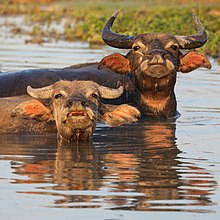
Back Акамбашь Abkhazian Keubeue ACE Bubalus bubalis AN جاموس الماء Arabic جاموس الماء ARZ Bubalus bubalis AST Гамущ AV Ayadol (Bubalus bubalis) AVK Asiya camışı Azerbaijani جامیشلار AZB
| Water buffalo | |
|---|---|

| |
| Water buffaloes in Laos | |
Domesticated
| |
| Scientific classification | |
| Domain: | Eukaryota |
| Kingdom: | Animalia |
| Phylum: | Chordata |
| Class: | Mammalia |
| Order: | Artiodactyla |
| Family: | Bovidae |
| Subfamily: | Bovinae |
| Genus: | Bubalus |
| Species: | B. bubalis
|
| Binomial name | |
| Bubalus bubalis | |

| |
| Global distribution of the water buffalo in 2004 | |
| Synonyms | |
|
Bos bubalis Linnaeus, 1758 | |
The water buffalo (Bubalus bubalis), also called the domestic water buffalo or Asian water buffalo, is a large bovid originating in the Indian subcontinent and Southeast Asia. Today, it is also found in Italy, the Balkans, Australia, North America, South America and some African countries.[1] Two extant types of water buffalo are recognized, based on morphological and behavioural criteria: the river buffalo of the Indian subcontinent and further west to the Balkans, Egypt and Italy and the swamp buffalo, found from Assam in the west through Southeast Asia to the Yangtze Valley of China in the east.[1][2]
The wild water buffalo (Bubalus arnee) most probable represents the ancestor of the domestic water buffalo.[3] Results of a phylogenetic study indicate that the river-type water buffalo probably originated in western India and was domesticated about 6,300 years ago, whereas the swamp-type originated independently from Mainland Southeast Asia and was domesticated about 3,000 to 7,000 years ago.[4] The river buffalo dispersed west as far as Egypt, the Balkans, and Italy; while swamp buffalo dispersed to the rest of Southeast Asia and up to the Yangtze Valley.[4][5][6]
Water buffaloes were traded from the Indus Valley Civilisation to Mesopotamia, in modern Iraq, in 2500 BC by the Meluhhas.[7] The seal of a scribe employed by an Akkadian king shows the sacrifice of water buffaloes.[8]
Water buffaloes are especially suitable for tilling rice fields, and their milk is richer in fat and protein than that of dairy cattle. A large feral population became established in northern Australia in the late 19th century, and there are smaller feral herds in Papua New Guinea, Tunisia and northeastern Argentina.[1] Feral herds are also present in New Britain, New Ireland, Irian Jaya, Colombia, Guyana, Suriname, Brazil, and Uruguay.[9]
- ^ a b c Cockrill, W. R. (1977). The water buffalo (PDF). Rome: Animal Production and Health Series No. 4. Food and Agriculture Organization of the United Nations. Archived from the original (PDF) on 16 June 2013.
- ^ Cockrill, W. R., ed. (1974). The husbandry and health of the domestic buffalo. Rome: Food and Agriculture Organization of the United Nations.
- ^ Lau, C. H.; Drinkwater, R. D.; Yusoff, K.; Tan, S. G.; Hetzel, D. J. S.; Barker, J. S. F. (1998). "Genetic diversity of Asian water buffalo (Bubalus bubalis): mitochondrial DNA D-loop and cytochrome b sequence variation" (PDF). Animal Genetics. 29 (4): 253–264. doi:10.1046/j.1365-2052.1998.00309.x. PMID 9745663.
- ^ a b Zhang, Y.; Colli, L. & Barker, J. S. F. (2020). "Asian water buffalo: domestication, history and genetics". Animal Genetics. 51 (2): 177–191. doi:10.1111/age.12911. PMID 31967365.
- ^ Cite error: The named reference
Liu2004was invoked but never defined (see the help page). - ^ Cite error: The named reference
yangwas invoked but never defined (see the help page). - ^ McIntosh, J. (2008). The Ancient Indus Valley: New Perspectives. Santa Barabara: ABC-CLIO. ISBN 9781576079072.
- ^ Khan, G., Church, S. K., Harding, R., Lunde, P., McIntosh, J., Stone, C. (2011). The First Civilizations in Contact: Mesopotamia and the Indus Archived 3 April 2019 at the Wayback Machine. The Civilizations in Contact Project, Faculty of Asian and Middle Eastern Studies, University of Cambridge.
- ^ Long, J. L. (2003). Introduced Mammals of the World: Their History, Distribution and Influence. Collingwood, Australia: Csiro Publishing. ISBN 9780643099166.
© MMXXIII Rich X Search. We shall prevail. All rights reserved. Rich X Search